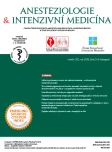The impact of videolaryngoscopy on the depth of endotracheal tube placement and the rate of unintended endobronchial intubation – a prospective randomized study
Authors:
V. Dostálová 1; J. Schreiberová 1; L. Kukrálová 1; M. Bartoš 2; P. Dostál 1
Authors‘ workplace:
Klinika anesteziologie, resuscitace a intenzivní medicíny, Fakultní nemocnice Hradec Králové, Lékařská fakulta v Hradci Králové, Univerzita Karlova
1; Neurochirurgická klinika, Fakultní nemocnice Hradec Králové, Lékařská fakulta v Hradci Králové, Univerzita Karlova
2
Published in:
Anest. intenziv. Med., 30, 2019, č. 3-4, s. 130-136
Category:
Overview
Background and goal of the study: Suboptimal visualisation of laryngeal structures could be associated with improper tracheal tube position or local airway trauma. The goal of this study was to compare the initial depth of tracheal tube insertion, rates of unintended endobronchial intubation, and postoperative patient discomfort after tracheal intubation using either videolaryngoscopy (GlideScope Titanium) or direct laryngoscopy (Macintosh blade).
Type of study: Prospective, randomized, open study.
Setting: Operating theatres of the University Hospital.
Materials and methods: Ninety adult ASA I – III patients scheduled for elective neurosurgical procedures were randomized into the direct laryngoscopy (C) and videolaryngoscopy (V) groups. Exclusion criteria included cervical spine surgery, planned postoperative ventilation and history of tracheal, laryngeal and cervical spine surgery. Intubation time, initial depth of tracheal tube insertion, tube position corrections due to signs of endobronchial intubation and sings of postextubation discomfort were recorded. Results are expressed as mean ± SD, mean (IQR) or as a percentage.
Results and discussion: There was a higher initial depth of tube placement (21 [20;22] cm vs. 22 [21;23] cm, P = 0.010) and a higher rate of endobronchial intubation (15.6% vs. 0.0%, P = 0.012) in the C group in comparison to the V group. There were no differences in postoperative rates of soar throat (20.0%, vs. 17.8%, P = 1.000), hoarseness (31.1% vs. 24.4%, P = 0.488), patient height (172.7 ± 10.3 vs. 173.5 ± 8.7 cm, P = 0.692) or male:female ratio (24/45 vs 19/45, P = 0.165) between groups.
Conclusion: The use of videolaryngoscopy is associated with a lower initial depth of tracheal tube insertion and a lower rate of unintended endobronchial intubation.
Keywords:
videolaryngoscopy – direct laryngoscopy – endobronchial intubation
Sources
1. Irefin S, Kopyeva T. Perioperative airway management. In: Sikka P, Beaman S, Street J, eds. Basic Clinical Anesthesia. New York: Springer; 2015:23–44.
2. Adnet F, Racine SX, Borron SW, et al. A survey of tracheal intubation difficulty in the operating room: a prospective observational study. Acta Anaesth Scand. 2001;45:327–332.
3. Lewis SR, Butler AR, Parker J, et al. Videolaryngoscopy versus direct laryngoscopy for adult patients requiring tracheal intubation. Cochrane Database of Systematic Reviews 2016, Issue 11. Art. No.: CD011136.
4. Brožek T, Michálek P. Role videolaryngoskopie v perioperační medicíně. Anest Intenziv Med. 2018;29:96–106.
5. Doyle DJ. The GlideScope video laryngoscope: a narrative review. Open Anesth J. 2017;11:48–67.
6. Cooper RM, Pacey JA, Bishop MJ, McCluskey SA. Early clinical experience with a new videolaryngoscope (GlideScope) in 728 patients. Can J Anesth. 2005;52:191–198.
7. Cooper RM. Complications associated with the use of the GlideScope® videolaryngoscope. Can J Anesth. 2007;54:54–57.
8. Griesdale DEG, Liu D, McKinney J, Choi PT. Glidescope® video-laryngoscopy versus direct laryngoscopy for endotracheal intubation: a systematic review and meta-analysis. J Can Anesth. 2012;59:41–52.
9. Tao B, Liu K, Wang D, et al. Comparison of GlideScope video laryngoscopy and direct laryngoscopy for tracheal intubation in neonates. Anesth Analg. 2019;129:482–486.
10. Gómez JC, Melo LP, Orozco Y, et al. Estimation of the optimum length of endotracheal tube insertion in adults. Rev Colomb Anestesiol. 2016;44:228–234.
11. Owen RL, Cheney FW. Endobronchial intubation: a preventable complication. Anesthesiology. 1987;67:255–257.
12. O’Connor CJ, Mansy H, Balk RA, et al. Identification of endotracheal tube malpositions using computerized analysis of breath sounds via electronic stethoscopes. Anesth Analg. 2005;101:735–739.
13. Cornelius B, Sakai T. Inadvertent endobronchial intubation in a patient with a short neck length. Anesth Prog. 2015;62:66–70.
14. Rudraraju P, Eisen L. Confirmation of endotracheal tube position: a narrative review. J Intensive Care Med. 2009;24:283–292.
15. Adriani J, Naraghi M, Ward M. Complications of endotracheal intubation. South Med J. 1988;81:739–744.
16. Verghese S, Hannallah R, Slack M, et al. Auscultation of bilateral breath sounds does not rule out endobronchial intubation in children. Anesth Analg. 2004;99:56–58.
17. Sitzwohl C, Langheinrich A, Schober A, et al. Endobronchial intubation detected by insertion depth of endotracheal tube, bilateral auscultation, or observation of chest movements: randomised trial. Br Med J. 2010;341:c5943.
18. McKay W, Klonarakis J, Pelivanov V, O’Brien J, Plewes C. Tracheal palpation to assess endotracheal tube depth: an exploratory study. Can J Anaesth. 2014; 61:229–234.
19. Pang G, Edwards M, Greenland K. Vocal cord-carina distance in anaesthetised Caucasian adults and its clinical implications for tracheal intubation. Anaesth Intensive Care. 2010; 38:1029–1033.
20. Evron S, Weisenberg M, Harow E, et al. Proper insertion depth of endotracheal tubes in adults by topographic landmarks measurements. J Clin Anesth. 2007;19:15–19.
21. Goodman LR, Conrardy, Laing F, Singer MM. Radiography evaluation of ETT position. Am J Roentgenol. 1976;127:433–434.
22. Schellinger RR. The length of the airway to the bifurcation of the trachea. Anesthesiology. 1964;25:169–172.
23. Liu DX, Ye Y, Zhu YH, et al. Intubation of non-difficult airways using video laryngoscope versus direct laryngoscope: a randomized, parallel-group study. BMC Anesthesiol. 2019;19:75.
Labels
Anaesthesiology, Resuscitation and Inten Intensive Care MedicineArticle was published in
Anaesthesiology and Intensive Care Medicine

2019 Issue 3-4
Most read in this issue
- Kapilární návrat – klinické vyšetření přítomnosti cirkulační koherence?
- Basic neuromodulation methods in chronic pain management
- De-escalation of antibiotic therapy as a part of care strategy about critically ill patients
- Zajištění obtížných dýchacích cest u dospělých a dětí
